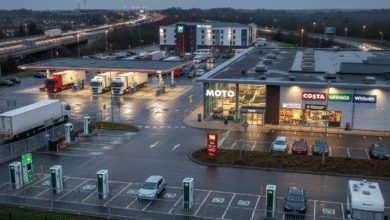Bristol Zoo Project: A Modern Conservation Hub Redefining the Future of Wildlife
How the Bristol Zoo Project Combines Conservation, Education, and Visitor Experience into One Unique Wildlife Destination

The Bristol Zoo Project is not just a traditional zoo but a forward-thinking conservation park dedicated to protecting endangered species, supporting global wildlife initiatives, and providing immersive educational experiences for visitors. Operated by the Bristol Zoological Society, the project combines large, naturalistic habitats, conservation-driven programs, and interactive learning opportunities, making it a must-visit destination for anyone passionate about wildlife and the future of biodiversity.
Introduction
When most people think of a zoo, they imagine cages, enclosures, and a chance to see exotic animals up close. The Bristol Zoo Project, however, goes far beyond this conventional image. Designed as a modern conservation hub, it is dedicated to saving species, inspiring communities, and redefining what a zoo can be in the 21st century. Nestled in Bristol and run by the Bristol Zoological Society, this expansive wildlife site has quickly gained recognition as a model for how zoos should balance animal welfare, public education, and conservation.
In this article, we will explore the origins of the Bristol Zoo Project, the unique animals it houses, its conservation efforts both locally and globally, and why it has become a top attraction for visitors who want to experience wildlife in a meaningful, responsible way.
History and Transformation of the Bristol Zoo Project
The story of the Bristol Zoo Project begins with the closure of the world-famous Bristol Zoo Gardens in Clifton in 2022. After nearly two centuries of operation, the zoo faced the challenge of adapting to modern expectations of animal welfare and conservation. Rather than maintaining outdated small enclosures in an urban setting, the Bristol Zoological Society shifted its focus to a larger, more natural site.
The Wild Place Project, which had been running since 2013, became the new home for Bristol’s zoological future. In 2023, it was rebranded as the Bristol Zoo Project to reflect its broader mission: not only to showcase animals but also to actively participate in wildlife conservation and research. This move symbolized a fundamental change from being a city zoo to becoming a world-class conservation park.
The Mission: More Than Just a Zoo
The Bristol Zoo Project is guided by a mission that extends far beyond public entertainment. Its core goals include:
Animal Welfare: Providing large, natural habitats that encourage animals to thrive physically and mentally.
Conservation: Running breeding programs for endangered species and supporting conservation projects worldwide.
Education: Inspiring children, students, and visitors to care about biodiversity through interactive learning experiences.
Sustainability: Creating an eco-friendly site that prioritizes environmental responsibility.
This holistic mission ensures that every aspect of the zoo project contributes to a greater purpose.
Immersive Habitats at the Bristol Zoo Project
The African Forest
One of the most exciting developments at the Bristol Zoo Project is the African Forest habitat. Designed to replicate the lush ecosystems of Central Africa, it is home to western lowland gorillas, cherry-crowned mangabeys, African grey parrots, and slender-snouted crocodiles. In the coming years, visitors will also encounter species like the okapi and mandrill, making it a living classroom for African biodiversity.2. Central African Savannah
This sweeping landscape recreates the vast savannahs of Africa, offering space for giraffes, zebras, and cheetahs. Plans are underway to introduce black rhinos and ostriches, creating a multi-species habitat that mirrors the balance of wild ecosystems.
Bear Wood
Closer to home, the Bear Wood habitat transports visitors to Britain’s ancient past, when bears, wolves, and lynx roamed the land. This immersive woodland exhibit highlights the importance of rewilding and restoring native ecosystems.
Conservation at the Heart of the Project
The Bristol Zoo Project is not simply about displaying animals; it is about protecting them for future generations. The zoo is committed to ensuring that 90% of the species it houses are linked to conservation programs by 2035.
Its conservation initiatives are twofold:
Global Conservation Programs
The Bristol Zoological Society supports projects in countries such as Madagascar, Cameroon, the Philippines, and Costa Rica. These projects focus on protecting critically endangered species like the lemur leaf frog, the Negros bleeding-heart dove, and the Kordofan giraffe. By combining fieldwork with breeding programs in Bristol, the society creates a global network of conservation impact.
Local UK Conservation Efforts
Closer to home, the zoo contributes to UK biodiversity by supporting projects such as the reintroduction of the white-clawed crayfish and the monitoring of rare insects like the necklace ground beetle and the silky wave moth. These efforts demonstrate that conservation begins in our own backyards.
Education and Community Engagement
A major strength of the Bristol Zoo Project is its commitment to education. The site regularly hosts school trips, university programs, and family learning sessions. Its Conservation Campus serves as a hub for research, veterinary training, and student involvement.
Children can participate in interactive trails, hands-on experiences, and seasonal events like Halloween “Howl-oween” nights. These programs aim to spark curiosity and foster a lifelong love of nature. For adults, lectures, volunteering opportunities, and conservation workshops create deeper connections to the project’s mission.
Visitor Experience at the Bristol Zoo Project
The Bristol Zoo Project is designed not only for animals but also for visitors. With over 136 acres of land, it offers plenty of space for walking, exploring, and connecting with nature.
Facilities Include:
A modern entrance building with a café and gift shop.
Play areas such as Explorers Basecamp for children.
Wooden walkways and observation decks that provide close yet respectful views of animals.
Sustainable features like electric vehicle charging points, cycling routes, and pedestrian-friendly access.
Unlike the old Bristol Zoo Gardens, which felt confined, the new project emphasizes open space and natural landscapes. Visitors often describe it as more relaxing, immersive, and inspiring.
Why the Bristol Zoo Project Matters
The importance of the Bristol Zoo Project goes beyond Bristol or even the UK. It is part of a larger global movement to redefine zoos as conservation centers rather than entertainment venues. By prioritizing animal welfare, sustainability, and education, the project sets an example for how zoos can evolve to meet modern ethical and ecological standards.
For families, it offers a chance to bond over shared experiences with wildlife. For students, it provides an educational platform that connects theory to practice. For conservationists, it is a living laboratory supporting species survival. And for the animals themselves, it is a sanctuary that respects their needs and natural behaviors.
Future Developments
The Bristol Zoo Project is continuously growing. Future phases include:
Expanding the African Forest to house more endangered species.
Developing the Conservation Campus further to accommodate advanced research.
Enhancing visitor experiences with new trails, habitats, and interactive programs.
Building stronger connections with conservation partners worldwide.
These plans ensure that the zoo will remain at the forefront of wildlife protection for decades to come.
Conclusion
The Bristol Zoo Project represents a new era in wildlife conservation and public engagement. It is more than just a place to see animals; it is a destination where visitors can learn, connect, and contribute to the preservation of biodiversity. With its expansive habitats, conservation-first mission, and dedication to education, it stands as a model for zoos of the future.
For anyone interested in animals, conservation, or sustainable tourism, the Bristol Zoo Project is not simply a recommendation—it is a must-visit.



